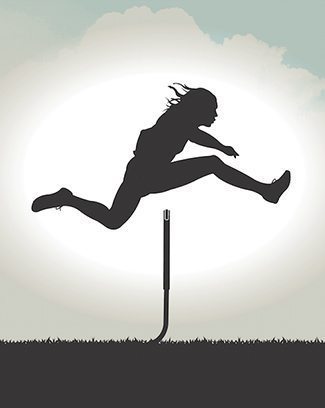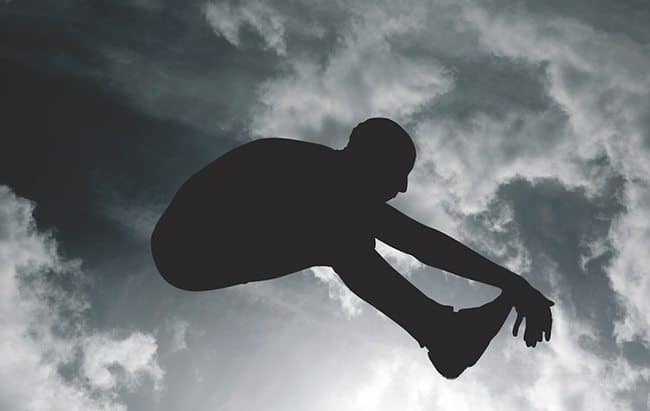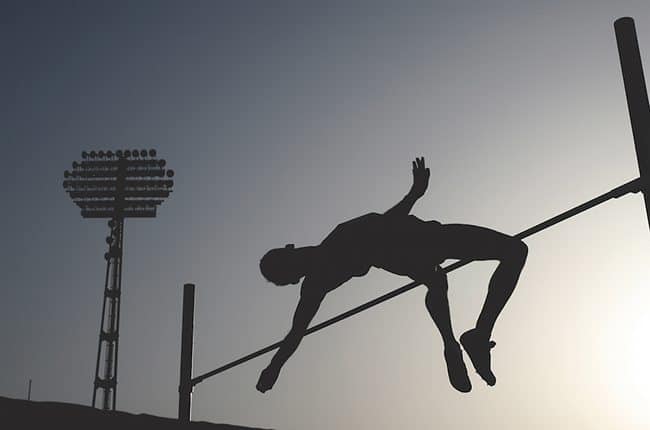Watching the games this month may give you a new perspective on perseverance.
BY VICTOR M. PARACHIN
‘You have to get over the hurdles and keep running.’
Those words often are spoken by Nawal El Moutawakel, Morocco’s Olympic gold medalist. After spending her childhood running through the streets of Casablanca, El Moutawakel used her running talent to earn a track scholarship to Iowa State University. There she won titles and, in 1984, became the only woman on the Moroccan team at the Los Angeles Olympics. She blew away her competition in the 400-meter hurdles earning Morocco its first gold medal, making history by becoming the first Muslim woman and first African woman to win a gold medal. As she ran her victory lap with a large Moroccan flag in hand, citizens back home poured into the streets of Casablanca in the middle of the night to celebrate.
A national hero, El Moutawakel uses her celebrity status to help other Muslim women in sports. Although Morocco supported her athletic effort, El Moutawakel knew other Muslim women were not as fortunate. She organized a women’s 10K race in Casablanca, which now draws more than 27,000 participants. El Moutawakel continues to provide sports leadership in her country.
Today she sums up her triumph saying: “My athletic race was the 400-meter hurdles, but it has been a metaphor for my life … You have to get over the hurdles and keep running.” That statement is excellent advice for everyone, especially those who are in positions of leadership. Working with others and guiding organizations means getting over hurdles and moving forward. Olympic athletes are among the most disciplined, determined and dedicated people on the planet. “The Olympics remain the most compelling search for excellence that exists in sport, and maybe in life itself,” says Dawn Fraser, an Australian swimmer and gold medalist. The lives of Olympians and their achievements offer these seven inspiring lessons in leadership.
1. Olympians know adversity can be turned into advantage.

Those hopes were dashed when, during a routine military training exercise, a grenade exploded in Takács’ right hand. His arm had to be amputated below the elbow. In the hospital, he experienced deep depression over the loss of his hand and his Olympic dreams.
However, he took on his greatest challenge, deciding he would relearn how to shoot with his left hand. For months Takács practiced by himself. Not even his closest companions knew what he was doing; he didn’t want any negative voices to discourage him.
In the spring of 1939 he showed up at the Hungarian National Pistol Shooting Championship. Other competitors greeted Takács, offering condolences, as well as commending him for coming to watch them shoot. “I didn’t come to watch,” he explained. “I came to compete.”
They were shocked and then stunned when he won the competition. Though the Olympics were cancelled in 1940 and 1944 because of World War II, Takács continued to train. He won gold medals at both the London (1948) and Helsinki (1952) Olympics. Ironically, pistol competitions don’t receive much attention, but Takács’ triumph over adversity generated great interest and enduring inspiration.
2. Olympians focus on the positive.
“When life hands you lemons, make lemonade” is a commonly spoken proverb. Olympic achievers set aside the negative to focus on the positive. During World War II, Tamio Kono and his parents were forced from their home in San Francisco to a Japanese internment camp in the California desert. A scrawny, asthmatic child, Kono found the desert climate better for his lungs. To pass the time, he began lifting weights and discovered he enjoyed it and was good at it. After the war, Kono continued training harder and harder. Within a decade he was the key factor in the success of the U.S. national weightlifting team. Despite his family detention, he proudly represented his country winning gold medals in 1952 and 1956, as well as a silver in 1960. The scrawny, unhealthy youth who was forced into an internment camp eventually set seven Olympic records and 26 world records. In addition, he went on to become Mister Universe three times. None of that may have happened had he not been confined to an internment camp where he focused on what was available, not what was left behind.
3. Olympians know the importance of integrity.
Abraham Lincoln said: “I desire so to conduct the affairs of this administration that if at the end, when I come to lay down the reins of power, I have lost every other friend on earth, I shall at least have one friend left, and that friend shall be down inside me.” That kind of integrity was important to Canadian Olympic sailor Lawrence Lemieux. At the 1988 Games in Seoul, Korea, Lemieux was sailing at a quick clip and on his way to the gold medal when he heard cries of two Singaporean sailors competing in a different event nearby. One of them was desperately clinging to his boat, which had capsized under 6-foot waves. The other sailor was swept more than 50 feet away by the currents. Lemieux recalled, “My thought process was, ‘Do they really need help?’ because a lot of times you are able to save yourself.” He called out to them but they couldn’t hear him. Instead of remaining in the race, Lemieux set course for the sailors, pulling them onto his boat. Later it became clear that one, if not both, of the sailors would have drowned without his help. Because of his actions Lemieux came in 23rd place.
“I could have won the gold,” he said, “but, in the same circumstances, I would do what I did again.” Lemieux’ act, however, did not go unrewarded. The International Olympic Committee presented him with the Pierre de Coubertin medal for sportsmanship. Olympic Committee President Juan Antonio Samaranch said, “By your sportsmanship, self-sacrifice and courage, you embody all that is right with the Olympic ideal.” Olympic athletes know the importance of integrity. They do not adhere to the mistaken philosophy of winning at all costs.
4. Olympians maintain a sense of justice and fairness toward others.
The best Olympians compete fiercely but also guide their lives by justice, fairness and comradeship. At the men’s pole vault event in the 1936 Berlin Olympics, five athletes reached the final competition. Among them were Earle Meadows of the United States and two Japanese athletes—Shuhei Nishida and Sueo Oe. Meadows took first place. After five hours of competition, Nishida and Oe tied for second place. The Japanese teammates were offered a final opportunity to have a jumpoff for the silver medal but the two friends declined out of mutual respect for each other. For the purposes of Olympic medal record keeping, Oe agreed to accept the bronze while Nishida took the silver. On their return to Japan, Nishida and Oe had a jeweler cut their Olympic medals in two and exchanged one piece with each other. Putting the bronze and silver halves together, they created a medal that came to be know all over Japan as the “Medal of Friendship.”
5. Olympians are highly determined and disciplined.
“Discipline is the refining fire by which talent becomes ability,” author Roy L. Smith says. For Olympians there are no shortcuts to success. They are not easily discouraged.
Clara Hughes was a 15-year-old girl who was inspired by the 1988 Olympic games held in Calgary. She turned to her mother and declared, “I want to go the Olympics for speed skating.” At 16 she took up the sport, eventually earning a berth on the Canadian team.
At the 2006 Winter Olympics in Turino, Italy, she earned a gold and a silver medal. Behind those moments of success was a long period of disciplined training. Hughes spent seven weeks of twice daily training so intense that she had to sleep between sessions just to get through the second one. Drills included bending so low in the skating position that it brought tears to her eyes and numbness from her toes to her nose.
“I think I can handle a lot of pain but that doesn’t help me when it’s going to happen again where I feel like my heart’s going to explode and my lungs are burning and my legs can’t even support my own weight,” Hughes says of the training regimen. “To actually go beyond that and to go harder in the last third in the race is something I don’t even like talking about it’s so hard. But that’s what I need to train for and that’s my goal, to get to that point, and be able to just viciously attack as if I am fighting for my life. That’s it. That’s all I want.” Hughes is one of the few Olympians to win medals in both the Winter and Summer Olympics, where she competed in road race cycling.
6. Olympians turn setbacks into comebacks.

Toward the end of World War II, Lis Hartel, a 23-year-old woman from Denmark was emerging as one of her country’s best equestrian riders. In 1944 she became pregnant and contracted polio. Although the illness left her almost totally paralyzed, she gave birth to a healthy baby girl. Determined to fight back and return to equestrian competition, Hartel began exercising. At first, she could only lift one arm and use some thigh muscles. Then she began to crawl, and within eight months of being diagnosed with paralyzing polio she was walking using crutches. Eventually she got on a horse again, and though she was paralyzed below the knees, she concentrated on how to ride and perform without the benefit of those muscles. Despite needing help mounting and dismounting from her horse, she competed for Denmark at the 1952 Games, winning a silver medal in a sport almost entirely dominated by healthy men. Her feat is even more remarkable when it is understood that dressage competition demands near-perfect interplay between horse and rider. The rider’s commands are supposed to be invisible—a nudge with the knee here, a tiny pull of the reins there. No loud, noisy commands are to be made. Hartel continued riding, winning another silver medal in the 1956 games.
7. Olympians break through excuses.
Many people squander their potential because of self-imposed limitations. They make excuses for why they cannot engage more fully with life: I don’t have time. I’m too young. I’m too old. I’m too tired. I’m uneducated. Etc., etc., etc. Olympians, on the other hand, simply refuse to accept reasons why things that need to be done can’t be done.
Consider Alice Coachman, the first African American gold medalist. At the Olympic Games in London (1948) Coachman won a gold medal in high jump. That year she also was the only female American athlete to win a medal of any kind. Coachman was born in 1923 in Albany, Georgia. She was one of 10 children in a very poor family. At that time, young African-American athletes could not use any of the training facilities or compete in any organized sporting events due to segregation, which was strictly enforced. In addition to dealing with racial segregation, Coachman also encountered widespread opposition to women in sports.
Though such issues easily could have become excuses to give up, Coachman took advantage of whatever opportunities she could find or create. She trained anywhere she could. To practice sprinting, she ran barefoot in fields and dirt roads close to her home. To practice the high jump, she improvised with homemade equipment, jumping over tied rags, ropes and sticks for hours at a time. Even her parents tried to dissuade her, saying she should devote her time to more productive areas. Nevertheless, Coachman pursued her dreams of becoming a world-class athlete. Her efforts began to pay off. In 1939, just prior to attending college on a scholarship, Coachman broke both the collegiate and national high jump records. In 1948 she qualified for the U.S. Olympic team with a high jump of 5 feet, 4 inches, breaking the existing 16-year-old record by ¾ of an inch. Decades later at the 1996 Atlanta Olympics, Coachman was named one of the 100 “greatest ever” Olympic athletes.
Like Olympians, today’s leaders avoid excuse making. They understand with this wisdom from French author Francois De La Rochefoucauld: “Nothing is impossible; there are ways that lead to everything, and if we had sufficient will we should always have sufficient means. It is often merely for an excuse that we say things are impossible.”






